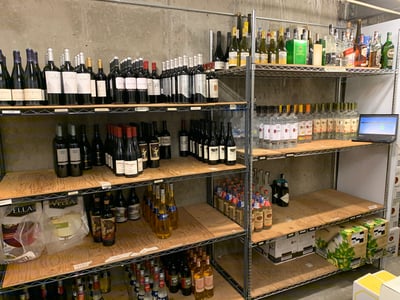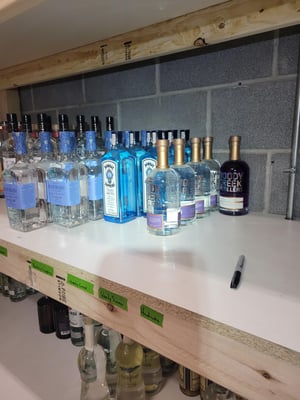 One of the biggest differences between front-of-house and back-of-house restaurant staff involves their level of formal training. It’s common for chefs, line cooks and other back-of-house staff to have graduated from culinary school or undergone some form of formal training. This is much less common among front-of-house staff such as servers and bartenders. Often, kitchens run by chefs and other cooks with formal training will operate more smoothly, and the processes established in these kitchens can also pay big dividends if they’re implemented by front-of-house staff.
One of the biggest differences between front-of-house and back-of-house restaurant staff involves their level of formal training. It’s common for chefs, line cooks and other back-of-house staff to have graduated from culinary school or undergone some form of formal training. This is much less common among front-of-house staff such as servers and bartenders. Often, kitchens run by chefs and other cooks with formal training will operate more smoothly, and the processes established in these kitchens can also pay big dividends if they’re implemented by front-of-house staff.
One critical process implemented in many well-run kitchens is the use of mise en place. Mise en place is a French term that means to “put in place.” Essentially, it involves making sure all ingredients are prepared and organized before the shift begins. In addition, all pans are prepared, and all tools, equipment and mixing bowls are set out.
This process allows the cooks in your kitchen to operate more efficiently. When all items are prepped in advance and all items are in their proper spot, your cooks won’t have to look for items in the middle of a busy rush. It also allows the kitchen staff to be more efficient with their movements. As a result, kitchens set up according to mise en place allow your staff to cook meals faster.
Mise en Place Can Improve the Efficiency of Your Bartenders
This concept can also be implemented behind the bar to make your bartenders more efficient during their shift. As an added benefit, it will also make your bar inventory counting process faster and more efficient.
When implementing mise en place behind your bar, keep the following guidelines in mind:
- Any order will be fine as long as everyone agrees on it – Having all bartenders agree on the order is much more important than the specific order you choose.
- Have a meeting to generate buy-in from your bar staff – Make your bartenders part of the process since they’re the people most impacted by the order that gets established. This can help generate ideas that will make your order more practical and efficient for the people who need to work in that space. It can also create a more logical order of items in situations where the specific order may actually matter, such as when ordering wine bottles behind the bar.
- Don’t overthink it – The most important point is to create an organizational structure that gives every item a set spot. While you want to put thought into the order you create, you don’t need to go overboard. Make a logical decision and move on.
Mise en Place Best Practices for Your Bar
As we stated earlier, there isn’t any one set order in which all bars should be organized. Each bar should choose a logical order that makes sense for their specific operations. However, there are certain big picture best practices you can adhere to that will make it easier to create an organizational system that will help your bartenders operate more efficiently during their shifts and speed up the time of your inventory counts.
Organize Your Wells First
 The reason to start with organizing your wells is that these are pretty straightforward, providing an easy win to get you in the mindset of creating an order for your bottles. We typically see most bars we work with order their wells from light liquors to dark liquors – vodka, then gin, then rum, then tequila, then whiskey, then scotch, then cordials.
The reason to start with organizing your wells is that these are pretty straightforward, providing an easy win to get you in the mindset of creating an order for your bottles. We typically see most bars we work with order their wells from light liquors to dark liquors – vodka, then gin, then rum, then tequila, then whiskey, then scotch, then cordials.
Keep in mind that this order isn’t a hard and fast rule. You can create any order you want for your wells. The most important thing is to create a set order that your staff agrees on.
Put Popular Products in the Most Convenient Places
Think about which is the most convenient shelf in your storage area for your staff to access. This is where you should place your well liquors and your most popular call liquors so that your bartenders can get to them quickly and easily when they need another bottle during a busy shift. Often, the chest-height shelf will be the most convenient location to access, so this is where your most popular items should live in your storage area.
Less popular items can go on the shelves above and below the chest-height shelf since they don’t need to be accessed as frequently.
Create a Set Order for Liquor Backups
While it’s most important to have set positions for every bottle behind the bar, you also want to create a set order for your backups in storage. This will make accessing bottles faster and easier when bartenders need to restock mid-shift. It will also make your inventory counts go much faster.
It’s helpful to group like liquors together in storage. In other words, group all wells together, all vodkas together, all whiskeys together, etc.
In addition to establishing a thoughtful order for your bottles in storage, it’s also important to label and/or map out the order of your storage area. This is especially critical for high volume bars that go through multiple bottles of their most popular liquors on a busy night.
When you label or map out your storage area and communicate this to your staff, they’ll not only be able to find the items they need more easily, but they will also be more likely to maintain the established order over time. Otherwise, it’s easy for your backups to become disorganized on a busy night and not get restocked properly.
Capacity Considerations Should Factor into Storage Room Organization
When you’re choosing places to store each item, think about what you need to have on hand for your busiest times of year. It’s common to need additional bottles in stock on nights such as New Year’s Eve, St. Patrick’s Day, the Super Bowl, and other occasions where your bar experiences higher volume than normal.
Make sure there’s enough space in each area for your max stock of every item. This is important in areas where high sales volume and low sales volume items are stored.
Consider Adding Shelves to Optimize the Use of Your Space
 Many bars must deal with small storage areas. You can do a lot more with small spaces when you put in shelves. Stacking cases on top of each other is usually going to cause your storage space to become cluttered and disorganized quickly, especially if you have a lot of broken cases. It’s easy to miscount inventory in these situations and you’ll often have to pull the cases apart, which slows down your counting time. Putting in shelves can help avoid these issues and improve the organization of your storage areas.
Many bars must deal with small storage areas. You can do a lot more with small spaces when you put in shelves. Stacking cases on top of each other is usually going to cause your storage space to become cluttered and disorganized quickly, especially if you have a lot of broken cases. It’s easy to miscount inventory in these situations and you’ll often have to pull the cases apart, which slows down your counting time. Putting in shelves can help avoid these issues and improve the organization of your storage areas.
You can get fancy and install custom built shelves, but this expense isn’t necessary. You can outfit your storage room with shelves much more affordably by getting them at restaurant supply stores or at Costco. We’ve also seen bars get creative with recycled building materials to make their shelves. As long as they’re sturdy, any shelves you use will get the job done.
Adding shelves allows you to create more storage space, and it becomes a lot easier to establish set positions for all of your items and keep your storage areas more organized. This will help your bartenders during busy shifts, and it will significantly speed up your counting time.
Use the Floor for Full Cases
While we don’t recommend stacking cases or keeping loose items on the floor, it’s perfectly fine to store full cases on the floor. Just make sure that only full cases are being stored here. Once a bottle is pulled out of the case, break it down and put the rest of the bottles on the shelf. This will eliminate issues associated with miscounting partial cases as full cases.
Mirror Your Stations and Coolers
While your wells may not all have the same number of bottles in them, it’s still a good idea to organize them in the same order (i.e. organize by type of liquor in the same order). Similarly, if you have two wine coolers, keep the same order philosophy (for example, organize the white styles and red styles in the same order in each cooler) even if you don’t have the exact same bottles in each cooler.
This will make it easier to keep everything organized in your stations and coolers, which will help your staff find the bottles they need faster. It will also speed up your counting time.
As an added benefit, using the same order philosophy for all stations and coolers will make it easier for less experienced servers and bartenders to learn about the products you carry. For example, if your wines are organized from light to heavy, your staff will be able to jumpstart their education on your offerings by looking at the way they are grouped on the shelf.
Build Maintenance of Your Mise en Place into Side Work
Once you’ve organized your bar and storage rooms into a set order, make sure this order is maintained by adding it to your closing side work. As part of your bartender’s job before they leave, they should make sure the liquor backups, wells and calls are all stocked and placed in the proper order. This will prevent your bar from falling back into disarray after every shift.
Adding this task to your side work will set up the staff working the next shift for success. Everything will always be organized in the proper order at the start of their shift, allowing them to hit the ground running. When you set your coworkers up for success, they’re more likely to do the same after their shift. However, when your staff shows up to a shift and finds everything in disarray, they’re much less likely to make the effort to keep the bar properly organized for the next shift.
Group Like Products Together
We’ve alluded to this in some of our other tips, but it’s always a smart idea to group like products together, both behind the bar and in the storage room. Wells should all be grouped together in both locations. In addition, all whiskeys should be grouped together, all vodkas should be grouped together, etc.
Use Strict Columns Where Possible
 If you have a shelf that has 15 bottles in a row from left to right, ideally when you look from the front of the shelf to the back of the shelf, you’d have columns devoted strictly to one type of liquor. In other words, you would have an entire column devoted to Jack Daniels bottles, an entire column devoted to Maker’s Mark bottles, etc.
If you have a shelf that has 15 bottles in a row from left to right, ideally when you look from the front of the shelf to the back of the shelf, you’d have columns devoted strictly to one type of liquor. In other words, you would have an entire column devoted to Jack Daniels bottles, an entire column devoted to Maker’s Mark bottles, etc.
Keep strict columns for medium to high volume items. For lower volume items, you may need to have columns that are mixed since these products may not have enough backstock to fill a full column. Make sure to label your columns so that your staff knows what should go there when they’re restocking.
Establish Pars for Beer and Wine Coolers
Coolers have limited storage space, so establishing pars is an effective way to make the best use of this limited space. Make sure you allot the largest number of spaces in the cooler for your most popular, highest selling products and keep fewer bottles of your slower selling products in each cooler. Doing this will reduce the number of trips your bartenders have to make to the storage area on a busy shift to restock popular products.
Putting a Little Thought and Effort into Your Bar’s Mise en Place Will Pay Huge Dividends
Most bars already put some thought into their organization, but there’s always room for improvement. Often, the organization of your bar and storage areas isn’t established explicitly. However, it is explicitly done in well run bars, particularly those that are high volume.
We’ve had the opportunity to work with some very high-volume bars which exceed $100,000 in weekly sales. We always notice that the most well run and successful of these high-volume bars have some process established for how they organize their bar.
Businesses in certain industries can create a competitive advantage which can’t be copied. If you manufacture a product using a proprietary process or technology, it can give you this kind of advantage. Unfortunately, this isn’t really possible in the restaurant industry.
Aside from your location, the one competitive advantage you can create in bars and restaurants involves how well you execute. Focusing on front-of-house mise en place is an easy way to establish a process that allows your staff to execute better than other bars.
There’s an added benefit to focusing on your bar’s mise en place. If things are well organized in your bar, this effort tends to spill over into other areas of the business. In these situations, you’ll generally see higher standards associated with the way customers are greeted, the way food and drinks are prepared, and the way other items are executed that will provide a better experience to your customers. Ultimately, this competitive advantage will not only make your operations run more efficiently, but they have the potential to generate larger profits.
Contact us today to find out how Bar-i’s inventory software can help you streamline your operations and boost profits. We serve bars and restaurants nationwide from our offices in Denver, Colorado.


-1.png)